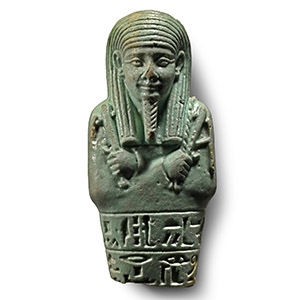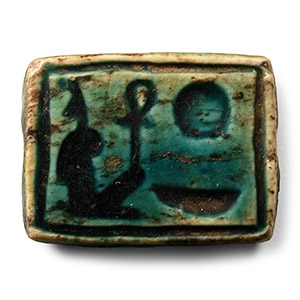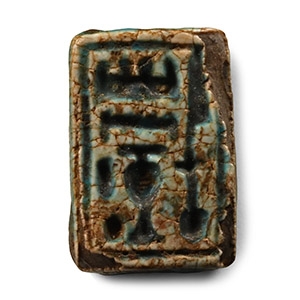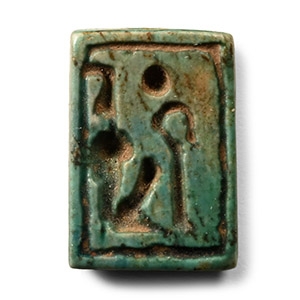Home > Auctions > 4 June - 8 June 2024
Ancient Art, Antiquities, Natural History & Coins
Auction Highlights:
Ex R. Liechti (1934-2010) Geneva, Switzerland, formed between 1950-1990s.
Cf. von Droste zu Hülsdorf, V. and Schlick-Nolte, B., Ägyptische Bildwerke II: Statuetten, Gefässe und Geräte, Melsungen, 1990, pp.236-237, no. 115, for an example with a similar form.
Acquired on the German art market, 1989-1995.
with The Museum Gallery, 19 Bury Place, London, WC1, UK, 1998-2003.
Property of a London based academic, 2003-present.
Cf. von Droste zu Hülsdorf, V. and Schlick-Nolte, B., Ägyptische Bildwerke II: Statuetten, Gefässe und Geräte, Melsungen, 1990, pp. 157-160, no. 77, for a shabti of similar styling.
Acquired on the German art market, 1989-1995.
with The Museum Gallery, 19 Bury Place, London, WC1, UK, 1998-2003.
Property of a London based academic, 2003-present.
Cf. Schlögl, H., and Brodbeck, A., Ägyptische Totenfiguren aus öffentlichen und privaten sammlungen der Schweiz, Göttingen, 1990, p. 259, no. 182, for the type.
Carieau family collection, Belgium, acquired in 1952.
Ex Maspero collection, Paris, 1963.
Acquired from a private European collection, in 1978.
Accompanied by a copy of a technical report by Edmund S. Meltzer Ph.D.
Accompanied by an academic report by Egyptologist Paul Whelan.
This lot has been checked against the Interpol Database of stolen works of art and is accompanied by a search certificate number no.12080-217053.
Cf. Newberry, P., Funerary Statuettes and Model Sarcophagi, Catalogue général des Antiquités égyptiennes du musée du Caire, Nos.46530-48575, Cairo 1930-1957, pp.378-379 (CG 48497), pl. XXI; see Donald, B., Funerary Figurines in Oxford Encyclopaedia of Ancient Egypt, vol 1, New York, 2000, pp.568-569; see also Schneider, H.D., Shabtis. An Introduction to the History of Ancient Egyptian Funerary Statuettes with a Catalogue of the Collection of Shabtis in the National Museum of Antiquities at Leiden, 3 vols., Leiden 1977, V.2, p.73, (3.2.1.55), pl.100; V.3 p.26.
Exhibited: The European Fine Art Foundation (TEFAF) 2016, Booth 430, Maastricht Exhibition & Congress Centre, Maastricht, Netherlands.
Acquired on the German art market, 1989-1995.
with The Museum Gallery, 19 Bury Place, London, WC1, UK, 1998-2003.
Property of a London based academic, 2003-present.
Cf. von Droste zu Hülsdorf, V. and Schlick-Nolte, B., Ägyptische Bildwerke II: Statuetten, Gefässe und Geräte, Melsungen, 1990, pp. 157-160, no. 77, for a shabti of similar styling.
European collection, latterly in private UK collection, 1990.
Read by John Taylor at the British Museum on 27 February 2009.
Accompanied by a copy of a handwritten information card and a print out of the Christie's example.
Cf. Christie's New York, 11 December 2014, lot 64, for another example, which sold for US $7,500.00; Aubert, L., Les statuettes funéraires de la Deuxième Cachette à Deir el-Bahari, Paris, 1998, p. 71, no. 19 and pl. X, for discussion and examples of Nesy-Amun's shabtis.
Nesy-Amun was the Fourth Prophet of Amun in the 21st Dynasty. The mummy was recovered from the priest's hole, cache II, Deir el-Bahari.
Acquired on the German art market, 1989-1995.
with The Museum Gallery, 19 Bury Place, London, WC1, UK, 1998-2003.
Property of a London based academic, 2003-present.
Although the individual's name is lost, his titles: 'member of the elite' and 'mayor/prince/governor', indicate his high status.
Probably from a priests’ cachette at Luxor.
Acquired in Egypt by Lieutenant James Alexander Goodman in the 1920s.
Thence by descent to his grandson.
Lieutenant Goodman served in the 4th Battalion Welsh Regiment during World War I and saw action in Palestine during the capture of Bethlehem, (for which he won an MC). After the war, he setup a business selling Fordson trucks and tractors in Alexandria, Egypt. A keen antiquarian, he collected ancient objects during his time in Alexandria and when he visited the pyramids at Giza. After his first marriage failed, he returned to the UK in the early 1930s. On his death in 1959, he passed his small collection of Egyptian objects on to his second wife, Ruby Goodman. On Ruby’s death in 1994, they were left to their second daughter, Rosemary Johnson, (née Goodman), and are currently in the possession of her son.
Ex Emile Bouillon Bey, c. 1880.
From the Gaston Maspero Archaeological Fund.
with Hotel des Ventes du Perigord, Bergerac, 24 June 2007.
Property of a French collector.
Cf. Petrie, W.M.F., Scarabs and Cylinders with Names, London, 1917, pl. XXXV, no. 154, for a variant of this design.
From the old collection of Emile Bouillon Bey, c. 1880.
Ex Gaston Maspero archaeological fund.
Property of a French collector.
Cf. Petrie, W.M.F., Scarabs and Cylinders with Names, London, 1917, pl. XXVII, no.57, for a similar block bead.
Thutmose III was a renowned warrior king widely revered even centuries after his reign.
Ex Emile Bouillon Bey, c. 1880.
From the Gaston Maspero Archaeological Fund.
with Hotel des Ventes du Perigord, Bergerac, 24 June 2007.
Property of a French collector.
Cf. Petrie, W.M.F., Button and Design Scarabs, London, 1925, pl. XXX, no. 1122, for a similar Bes design on a block bead.
Bes became one of ancient Egypt's most popular apotropaic deities from the New Kingdom onwards. Despite his somewhat fearful appearance, Bes was the patron and protector of pregnant women and children. He was also believed to protect from snakes.
Ex Emile Bouillon Bey, c. 1880.
From the Gaston Maspero Archaeological Fund.
with Hotel des Ventes du Perigord, Bergerac, 24 June 2007.
Property of a French collector.
Cf. Petrie, W.M.F., Scarabs and Cylinders with Names, London, 1917, pl. XLV, no.6, for a scarab with the throne name, nos. 12-13, for similar Ramesside block bead types.
13 - 24 of 2809 LOTS

.jpg)

.jpg)
.jpg)
.jpg)
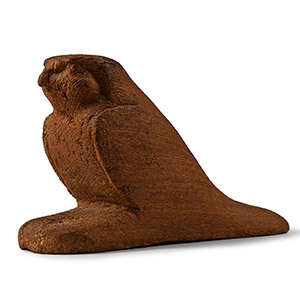
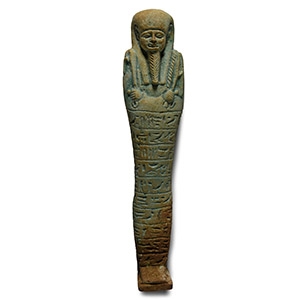

.jpg)
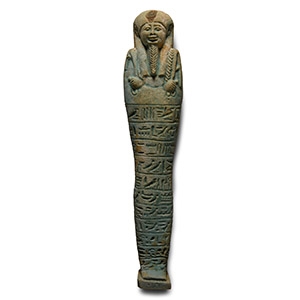
.jpg)
